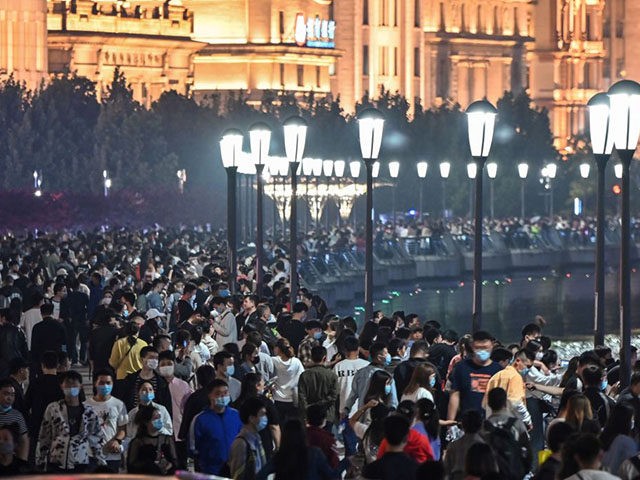Chinese government media outlets predicted a “travel bonanza” on May Day, or May 1, on Wednesday as “red” tourists prepare to visit historic sites to celebrate 100 years of mass killings, poverty, and repression under the Chinese Communist Party.
“May Day,” sometimes known as “International Workers’ Day” or “Labor Day,” is a day in which communists organize observances to celebrate the ideology and worship its heroes. May Day celebrations were muted worldwide in 2020 as the Chinese coronavirus pandemic — a product of communist government mismanagement — largely prevented travel and mass gatherings. Even China, which by May 2020 had claimed to overcome its internal coronavirus outbreak, did not encourage the masses to flock to Beijing or organize its typically lavish parades.
This year marks the 100th anniversary of the founding of the Communist Party, which China’s CCTV state broadcaster expressed hope would encourage “buzzing travelers and tourists” to relive the alleged glory days of Mao Zedong by visiting historic sites. The Chinese government appears to be encouraging mass travel even as its national vaccination program lags behind the world’s other largest nations, in part due to repeated government assurances that the virus no longer poses a threat to the country.
“A travel bonanza is fast approaching as tickets during the upcoming five-day Labor Day holiday starting on May 1 have been in high demand,” CCTV predicted this week. “On online travel booking platform Ctrip, orders for flight tickets, accommodation, admission tickets, and car rentals rose 23 percent, 43 percent, 114 percent, and 126 percent from the same period of 2019 as of mid-April.”
Pent-up demand for travel, the outlet continued, may result in a greater number of people traveling in 2021 than prior to the pandemic. CCTV suggested that as many as 200 million people would take vacations to celebrate communism this year and 4.1 billion Chinese people may plan “domestic tourist trips” by the end of 2021, a 42 percent increase from 2020, generating $508 billion.
State-run media outlets had predicted that 200 million people would travel on May Day previously in April, also advertising as many as 20 large-scale music festivals nationwide to celebrate the occasion, despite the ongoing pandemic and low vaccinations in the country. Wuhan, where the virus originated, will be home to one of these events, the Strawberry Music Festival. Wuhan experienced a resurgence of coronavirus cases in January after the state organized a large New Year’s Eve gathering to prove that the Communist Party had contained the spread of the disease.
The government highly encourages “red tourism,” or visits to popular communist sites, for both economic and ideological reasons. Tour companies have designed elaborate itineraries for avid communists interested in reliving some of the worst moments in the history of communist China, CCTV reported.
“We have rolled out a two-week tour to retrace the Long March route of the Red Army in the 1930s, which has attracted many retired people who have the money and time as well as the desire to pay their respects to the heroes,” Zhao Chenyan of the Beijing Zhuyuan International Travel Service Co., Ltd., told the network. The Long March killed at least 30,000 people.
Zhao added that regions currently enduring some of the most atrocious human rights atrocities committed by the modern Chinese Communist Party — like Xinjiang, home to the nation’s Uyghur concentration camps, or occupied Tibet — are also popular this time of year because the extended time off allows for travel further away from home.
The Chinese government newspaper Global Times highlighted the role that elderly Chinese communists play in “red tourism,” as they tend to show greater enthusiasm for the ideology than younger Chinese who suffer from the malaise that comes with living in a totalitarian society.
“The popularity of red tourism during the May Day holidays is expected to soar as many Chinese people are planning to visit red tourism attractions in the coming May Day vacation to celebrate the centenary of the CPC,” the newspaper predicted, citing Chinese officials.
“Many red-themed scenic spots have become places for middle-aged and elderly people to relive their youth and passion and reflect on the changes of the times, and for young people to listen to historic stories and pay tribute to heroes and role models,” one of those officials, Ministry of Culture and Tourism publicity professional Hu Heping, noted this year in remarks excerpted by the state newspaper.
The Global Times also noted the few fervently communist Millennials in China also enjoy bringing their young children to historic sites to indoctrinate them into gratitude for the Communist Party. One such millennial, 38-year-old Yu Yue, told the outlet that she is planning to travel with her six-year-old daughter to a Long March site to teach her “that the happy life today was thanks to the sacrifice of countless revolutionary martyrs.”
Chinese tourism officials attempted to promote tourism during the 2020 May Day season by encouraging the use of masks and implementing an extension of the social credit system that offered detailed medical information to government officials through the use of a mobile phone QR code. Tourism was nonetheless down 83 percent on the first day of the May Day holiday in Hubei province, where Wuhan is located.
The Party took heightened precautionary measures in Beijing that year, where the senior officials in the party live, organizing a large flower display but no parade in Tiananmen Square, site of one of the Communist Party’s deadliest massacres in 1989.

COMMENTS
Please let us know if you're having issues with commenting.